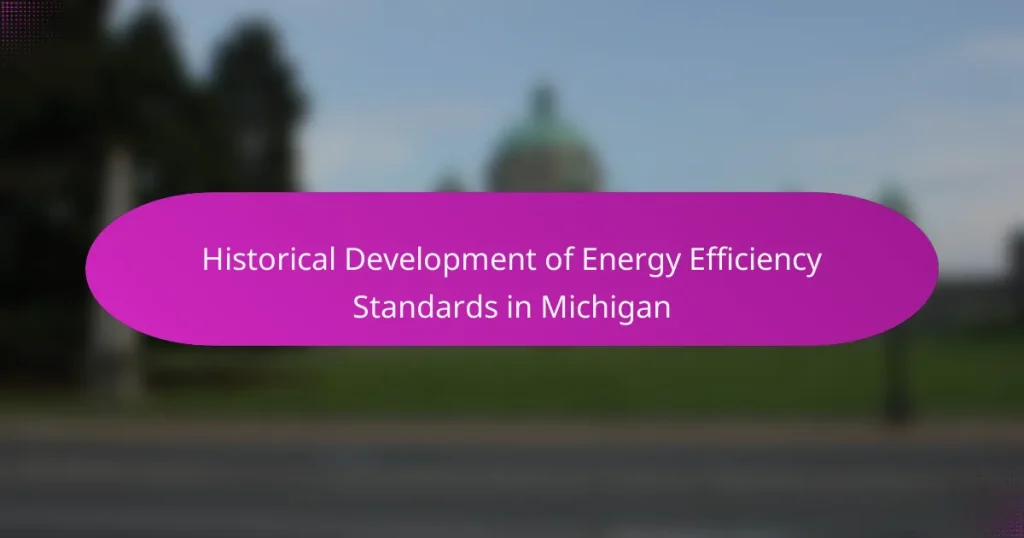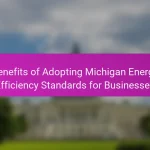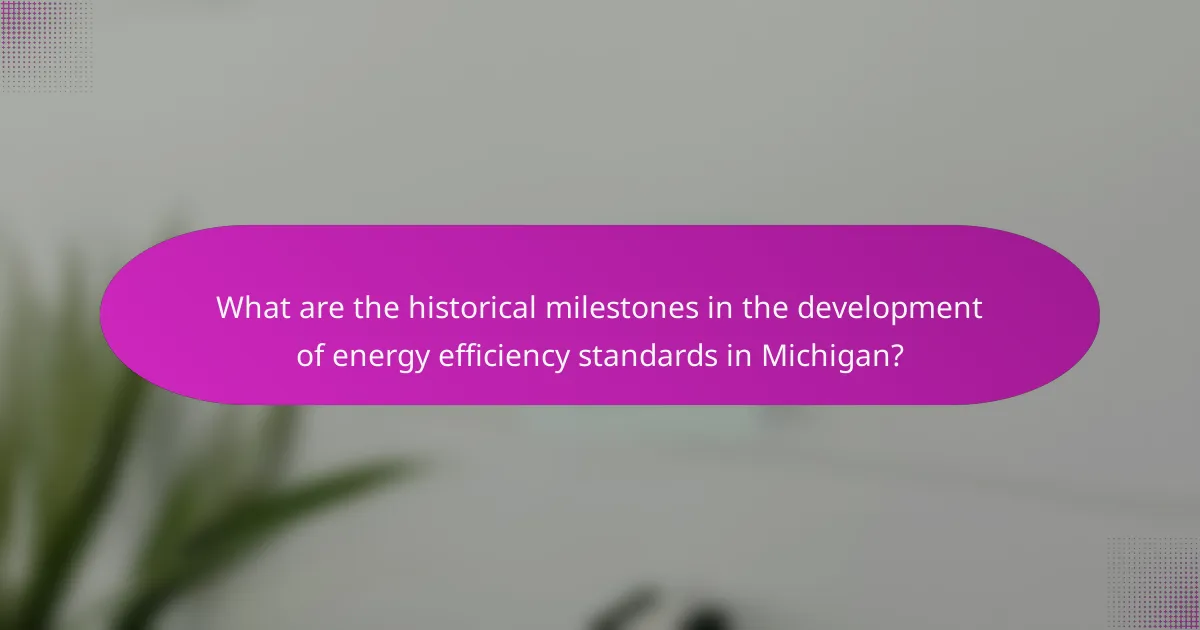
What are the historical milestones in the development of energy efficiency standards in Michigan?
The historical milestones in the development of energy efficiency standards in Michigan include several key events. In 1999, Michigan established the Energy Efficiency Program through Public Act 142. This act aimed to create utility energy efficiency programs. In 2008, the Michigan Public Service Commission (MPSC) implemented the Energy Optimization Standard. This standard mandated utilities to achieve specific energy savings goals. In 2016, the state passed Public Act 342, which set more aggressive energy efficiency targets. This act required utilities to achieve a 1% reduction in energy sales annually. In 2020, the MPSC reported that energy efficiency programs saved over 1.4 billion kWh. These milestones reflect Michigan’s commitment to improving energy efficiency standards over the years.
How did the energy crisis of the 1970s influence Michigan’s energy efficiency standards?
The energy crisis of the 1970s significantly influenced Michigan’s energy efficiency standards. In response to rising oil prices and supply shortages, the state prioritized energy conservation. This led to the establishment of regulations aimed at improving energy efficiency in buildings and appliances. The Michigan Energy Office was created in 1976 to promote energy conservation efforts. Legislation was enacted to set minimum efficiency standards for various energy-consuming devices. These measures were part of a broader national trend toward energy efficiency. The crisis underscored the importance of reducing reliance on fossil fuels. Consequently, Michigan adopted policies that encouraged renewable energy sources and energy-saving technologies.
What specific policies were introduced in response to the energy crisis?
In response to the energy crisis, Michigan introduced several specific policies aimed at improving energy efficiency. These policies included the implementation of energy efficiency standards for appliances and buildings. The state established the Michigan Energy Optimization Program to promote energy-saving measures. Additionally, Michigan adopted the Public Act 295 of 2008, which mandated a reduction in energy consumption by utilities. This act required utilities to develop energy waste reduction plans. The state also incentivized renewable energy development through tax credits and grants. These policies collectively aimed to mitigate the impacts of the energy crisis and promote sustainable energy practices in Michigan.
How did public awareness shape the development of these standards?
Public awareness significantly influenced the development of energy efficiency standards in Michigan. Increased public concern about energy consumption and environmental impact led to greater demand for regulatory action. Advocacy groups raised awareness about the benefits of energy efficiency, pushing for legislative changes. Public campaigns highlighted the economic advantages of reducing energy use. As a result, policymakers began to prioritize energy efficiency in their agendas. Surveys indicated that a majority of residents supported stronger energy regulations. This public backing provided the necessary momentum for implementing new standards. Ultimately, heightened awareness helped shape a more sustainable energy policy in Michigan.
What role have state agencies played in establishing energy efficiency standards in Michigan?
State agencies in Michigan have been instrumental in establishing energy efficiency standards. They develop regulations and guidelines to promote energy conservation. The Michigan Public Service Commission (MPSC) oversees utility energy efficiency programs. The MPSC sets performance standards for utilities to achieve energy savings. Additionally, the Department of Energy, Labor & Economic Growth (DELEG) supports energy efficiency initiatives. DELEG provides funding and resources for energy efficiency projects. These agencies collaborate with stakeholders to create effective policies. Their efforts have led to measurable reductions in energy consumption across the state.
Which key agencies were involved in the formulation of these standards?
The key agencies involved in the formulation of energy efficiency standards in Michigan include the Michigan Department of Energy, Great Lakes, and Environment (EGLE) and the Michigan Public Service Commission (MPSC). These agencies played significant roles in developing and implementing policies for energy efficiency. EGLE focuses on environmental protection and energy conservation efforts. MPSC regulates utility services and promotes energy efficiency programs. Their collaboration has been essential in establishing standards that promote sustainable energy practices in Michigan.
How have these agencies collaborated with other stakeholders?
Agencies have collaborated with other stakeholders through partnerships and joint initiatives. They have engaged with utility companies to align energy efficiency programs. Collaboration with state and local governments has facilitated regulatory support. These agencies have also worked with non-profit organizations to promote community awareness. Research institutions have been involved in developing best practices and guidelines. Stakeholder forums have been organized to gather input and feedback. This collaborative approach has led to more effective energy efficiency standards. It has resulted in measurable energy savings across Michigan.
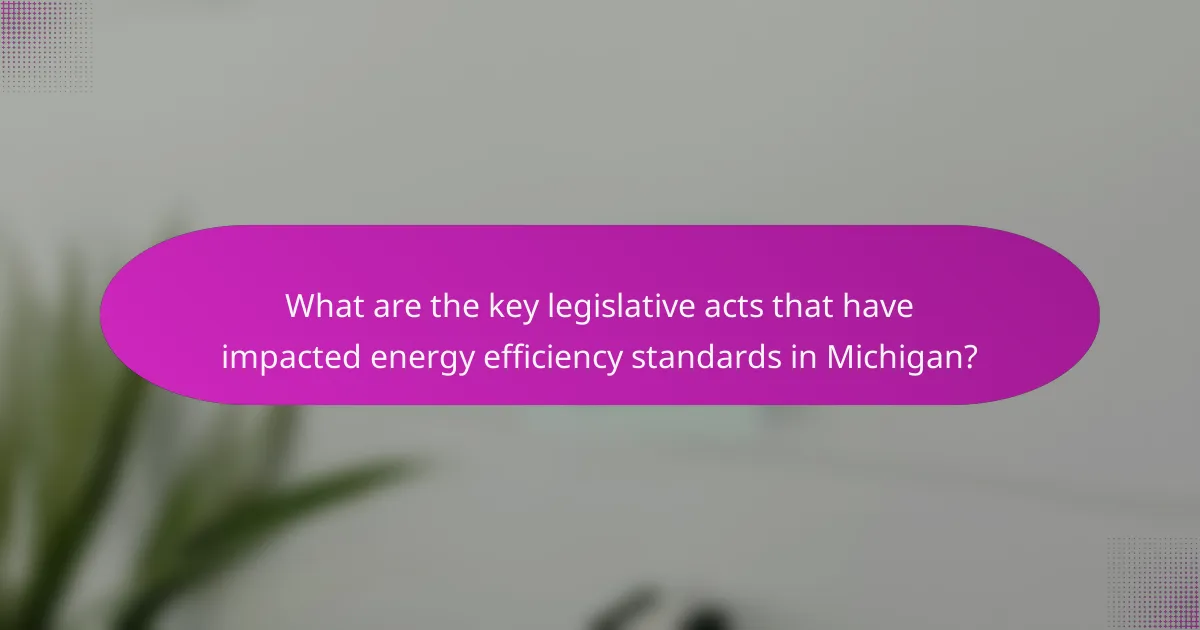
What are the key legislative acts that have impacted energy efficiency standards in Michigan?
The key legislative acts that have impacted energy efficiency standards in Michigan include the Energy Efficiency Resource Standard (EERS) established in 2008. This act set specific energy savings targets for utilities. Another significant act is the Clean, Renewable, and Efficient Energy Act of 2008. This act promoted renewable energy and energy efficiency initiatives. The 2016 Michigan Energy Law also played a crucial role by extending and enhancing energy efficiency programs. These acts collectively aimed to reduce energy consumption and promote sustainable practices in the state.
What was the significance of the Michigan Energy Efficiency Act?
The Michigan Energy Efficiency Act was significant for establishing comprehensive energy efficiency standards in the state. It aimed to reduce energy consumption and promote sustainable practices. The Act set specific energy savings targets for utilities, requiring them to implement energy-saving programs. This legislation marked a shift towards prioritizing energy efficiency in Michigan’s energy policy. It also encouraged investment in energy-efficient technologies and practices among consumers and businesses. The Act contributed to reducing greenhouse gas emissions and lowering energy costs for residents. By fostering a culture of energy conservation, it played a crucial role in the state’s overall energy strategy.
How did this act change the landscape of energy efficiency in the state?
This act significantly improved energy efficiency standards in Michigan. It established mandatory energy-saving measures for residential and commercial buildings. The legislation required utilities to implement energy efficiency programs. These programs aimed to reduce energy consumption and lower costs for consumers. The act led to increased investment in energy-efficient technologies. As a result, energy savings in the state rose substantially. According to the Michigan Public Service Commission, energy efficiency programs saved over 1 billion kWh in the first year alone. This act transformed the approach to energy management in Michigan.
What specific requirements were mandated by this act?
The act mandated specific energy efficiency standards for residential and commercial buildings. These standards included requirements for insulation, lighting, and heating systems. Compliance with these standards aimed to reduce energy consumption and greenhouse gas emissions. The act also required periodic updates to the standards based on technological advancements. Additionally, it mandated the establishment of a state energy office to oversee implementation. Local governments were encouraged to adopt these standards into their building codes. The act aimed to enhance overall energy efficiency across Michigan.
How have federal regulations influenced Michigan’s energy efficiency standards?
Federal regulations have significantly shaped Michigan’s energy efficiency standards. The U.S. Department of Energy (DOE) sets national energy efficiency benchmarks. These benchmarks often serve as a baseline for state regulations. Michigan aligns its standards with federal guidelines to ensure compliance. For example, the Energy Policy Act of 2005 prompted states to adopt stricter energy efficiency measures. This act led to Michigan implementing the Energy Optimization Act in 2008. Additionally, federal incentives encourage utilities to invest in energy-saving programs. As a result, these regulations have driven improvements in energy efficiency across the state.
What federal programs have been implemented to support state-level efficiency initiatives?
The federal programs implemented to support state-level efficiency initiatives include the Energy Efficiency and Conservation Block Grant (EECBG) Program and the Weatherization Assistance Program (WAP). The EECBG Program provides funding to local governments for energy efficiency projects. This program aims to reduce energy consumption and promote renewable energy technologies. The Weatherization Assistance Program helps low-income households improve energy efficiency. It provides funding for home energy upgrades, which can lower utility bills. These programs have been essential in facilitating state-level initiatives across the country, including Michigan. They offer financial resources and technical assistance to enhance energy efficiency efforts at the state level.
How do these federal regulations align with Michigan’s goals?
Federal regulations support Michigan’s goals for energy efficiency. These regulations aim to reduce energy consumption and greenhouse gas emissions. Michigan’s energy policies prioritize sustainability and economic growth. The alignment enhances the state’s commitment to cleaner energy. Federal standards provide a framework that Michigan can adopt and adapt. This creates consistency between state and federal efforts. Additionally, compliance with federal regulations can lead to funding opportunities for Michigan. Overall, these regulations reinforce Michigan’s objectives for a more efficient energy future.
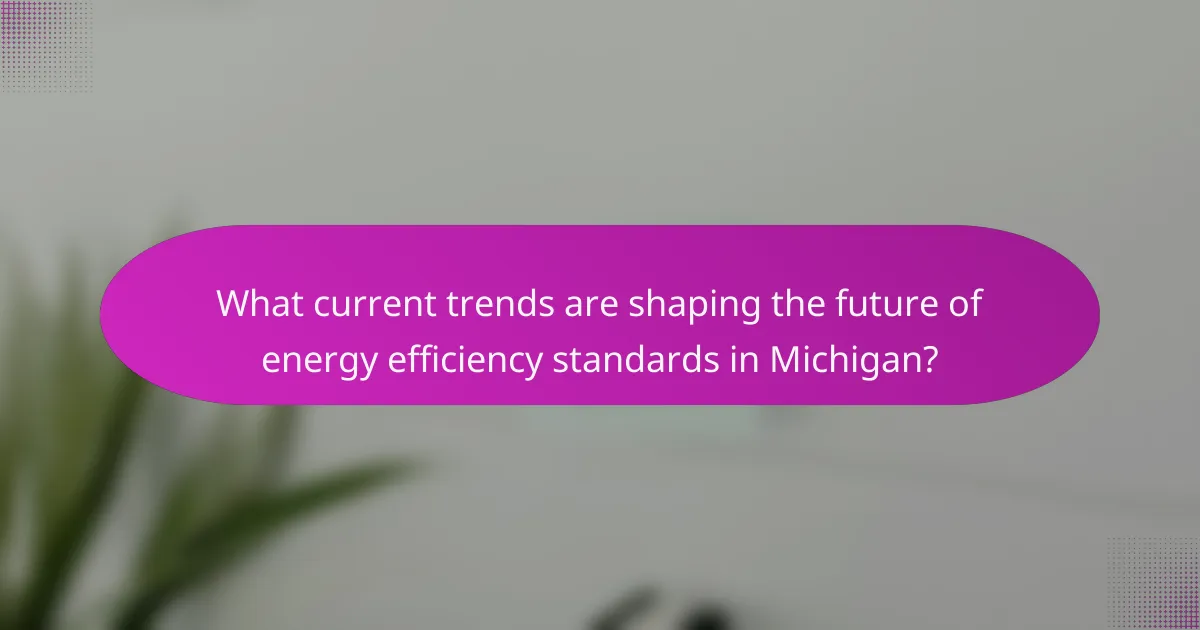
What current trends are shaping the future of energy efficiency standards in Michigan?
Current trends shaping energy efficiency standards in Michigan include increased regulatory measures, advancements in technology, and a focus on renewable energy integration. The Michigan Public Service Commission (MPSC) is implementing stricter energy efficiency mandates for utilities. These mandates aim to reduce energy consumption by 1% annually, as outlined in the 2016 Energy Optimization Act. Additionally, smart technology is enhancing energy management capabilities in residential and commercial sectors. The rise of electric vehicles is also influencing infrastructure planning and energy consumption patterns. As of 2023, Michigan is prioritizing sustainability with incentives for energy-efficient appliances and home retrofitting programs. These trends reflect a broader commitment to reducing greenhouse gas emissions and promoting sustainable energy practices in the state.
How is technology impacting the development of energy efficiency standards?
Technology is significantly impacting the development of energy efficiency standards. Innovations in energy-efficient technologies lead to enhanced performance measures. Smart meters and IoT devices enable real-time energy monitoring. This data helps in setting more precise efficiency benchmarks. Advanced building materials improve insulation and reduce energy consumption. Software tools optimize energy use in commercial buildings. Regulatory bodies adapt standards based on technological advancements. For instance, the U.S. Department of Energy regularly updates efficiency guidelines. These updates reflect the latest technological capabilities and consumer needs.
What innovative technologies are being integrated into energy efficiency measures?
Innovative technologies integrated into energy efficiency measures include smart meters, energy management systems, and advanced HVAC systems. Smart meters allow real-time monitoring of energy consumption. This enables consumers to adjust usage based on peak pricing. Energy management systems optimize energy use in buildings. They analyze data to reduce waste and improve efficiency. Advanced HVAC systems use variable refrigerant flow technology. This technology adjusts cooling and heating based on occupancy. Additionally, LED lighting has become standard due to its low energy consumption. Renewable energy integration, such as solar panels, further enhances energy efficiency. These technologies collectively contribute to reduced energy costs and lower carbon emissions.
How are smart grids influencing standards and regulations?
Smart grids are significantly influencing standards and regulations in the energy sector. They enable real-time data exchange between utilities and consumers. This capability encourages the development of new efficiency standards. Regulatory bodies are adapting to incorporate smart grid technologies. Enhanced data analytics improve demand response strategies. This leads to more precise energy consumption regulations. Additionally, smart grids support renewable energy integration, prompting new guidelines for grid interconnections. As a result, standards evolve to promote sustainability and resilience.
What challenges does Michigan face in advancing energy efficiency standards?
Michigan faces several challenges in advancing energy efficiency standards. One major challenge is the lack of consistent funding for energy efficiency programs. This inconsistency hinders the implementation of long-term initiatives. Additionally, there is resistance from various stakeholders, including utility companies. Some utilities prioritize short-term profits over long-term energy savings. Another challenge is the complexity of regulatory frameworks. Navigating these regulations can slow down the adoption of new standards. Furthermore, public awareness and education on energy efficiency are lacking. Many residents are unaware of the benefits of energy-efficient practices. Lastly, there is competition for resources among various energy policies. This competition can dilute the focus on energy efficiency standards.
What barriers exist in policy implementation and public adoption?
Barriers in policy implementation and public adoption of energy efficiency standards in Michigan include lack of funding, insufficient stakeholder engagement, and limited public awareness. Funding constraints hinder the development and execution of programs. Stakeholder engagement is often inadequate, leading to misalignment between policy goals and public needs. Limited public awareness results in low participation rates. According to a 2020 report by the Michigan Energy Office, 60% of residents are unaware of energy efficiency programs available to them. Additionally, regulatory complexity can create confusion, further impeding adoption.
How can these challenges be addressed for future improvements?
Identifying and addressing challenges in energy efficiency standards can lead to significant improvements. Engaging stakeholders, including industry experts and community members, is essential for gathering diverse perspectives. Regularly updating standards based on technological advancements ensures they remain relevant. Implementing training programs enhances compliance and understanding among builders and contractors. Establishing clear metrics for evaluating energy efficiency can guide future policy adjustments. Research indicates that states with adaptive standards see a 20% increase in energy savings over a decade. Continuous feedback loops allow for real-time adjustments to standards based on performance data. These strategies collectively foster a more efficient energy landscape in Michigan.
What best practices can be adopted for effective energy efficiency standards in Michigan?
Adopting best practices for effective energy efficiency standards in Michigan involves several key strategies. Implementing comprehensive energy audits can identify areas for improvement in buildings. Establishing clear benchmarks for energy performance encourages accountability among stakeholders. Providing financial incentives for energy-efficient upgrades can motivate businesses and homeowners to invest. Promoting public awareness campaigns can educate residents about energy-saving practices. Collaborating with local utilities ensures alignment with energy supply and demand. Lastly, regularly updating standards based on technological advancements keeps regulations relevant and effective. These practices collectively enhance energy efficiency and contribute to sustainable development in Michigan.
What lessons can be learned from other states’ approaches to energy efficiency?
States can learn several lessons from other states’ approaches to energy efficiency. First, successful states often implement comprehensive policies that include financial incentives. For example, California’s energy efficiency programs have resulted in significant savings, demonstrating the effectiveness of rebates and tax credits. Second, collaboration with utilities enhances program reach and effectiveness. Massachusetts has partnered with utility companies to deliver energy-saving programs, achieving impressive participation rates. Third, public awareness campaigns are crucial. New York’s outreach efforts have increased consumer engagement in energy efficiency initiatives. Lastly, data-driven approaches help in tracking progress and optimizing programs. The Energy Trust of Oregon uses data analytics to improve its energy efficiency strategies. These lessons highlight the importance of incentives, partnerships, public engagement, and data utilization in enhancing energy efficiency efforts.
How can stakeholders collaborate to enhance energy efficiency initiatives?
Stakeholders can collaborate to enhance energy efficiency initiatives by sharing resources and expertise. This collaboration can involve government agencies, businesses, and non-profit organizations working together. They can create joint programs that promote energy-saving technologies. Regular meetings can help align strategies and goals. Data sharing allows stakeholders to track progress and identify best practices. Financial incentives can be pooled to support larger projects. Educational campaigns can raise awareness about energy efficiency. Research partnerships can drive innovation in energy-saving solutions. These collaborative efforts can lead to significant improvements in energy efficiency outcomes.
The main entity of the article is the historical development of energy efficiency standards in Michigan. The article outlines key milestones in Michigan’s energy efficiency journey, starting from the establishment of the Energy Efficiency Program in 1999 to the implementation of the Energy Optimization Standard in 2008 and subsequent legislative acts aimed at enhancing energy efficiency. It discusses the influence of the 1970s energy crisis on policy formation, the role of state agencies in developing standards, and the impact of federal regulations. Additionally, the article examines current trends, challenges, and best practices for advancing energy efficiency initiatives in Michigan.
